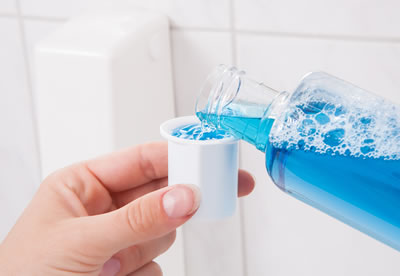
Mouthwash & Your Waterpik™ Water Flosser
What's Safe to Use
Although all you need in your water flosser for effectiveness is warm water, you might wonder whether it is safe to use mouthwash or other additives. Can they damage the unit? What's not okay to use?
Find the answers to these questions and learn what you can add to your water flossing routine.
Safe for WaterpikTM Water Flossers
Standard Mouthwash
Standard or cosmetic mouthwash neutralizes odors and freshens your breath.
To use standard mouthwash:
- Add a small amount of mouthwash to a reservoir filled with warm water (to prevent damage to the unit, do not exceed a 1:1 ratio of mouthwash to water).
- Water floss as described in the product instructions.
- Rinse the unit by partially filling the reservoir with plain warm water and running it with the tip pointed into the sink.
Antiseptic Mouthwash
Antiseptic mouthwashes contain agents that prevent growth of microorganisms in the mouth. They are formulated to help prevent gingivitis and gum disease.
To use antiseptic mouthwash:
- To prevent damage to the unit, add no more than a 1:1 ratio of antiseptic mouthwash to warm water to the reservoir.
- Water floss as described in the product instructions.
- Rinse the unit by partially filling the reservoir with plain warm water and running it with the tip pointed into the sink.
Water Flosser Additives
YES - Safe to Use
Standard mouthwash
Antiseptic mouthwash
Therapeutic mouth rinse
Hydrogen peroxide (3% solution)
NO - Do Not Use
Water insoluble concentrated essential oils
Iodine
Baking soda
Saline (salt) solution in cordless handheld units
Therapeutic Mouth Rinse
Dental professionals prescribe therapeutic mouth rinses to help treat gum disease. These prescription-only solutions typically contain the antimicrobial drug chlorhexidine gluconate (CHX) and include brands such as PeridexTM and Periogard®.
If you have gum disease with periodontal pockets, your dental professional may recommend cleaning them using a WATERPIK water flosser and the Pik Pocket™ tip.
To use therapeutic mouth rinses:
- Follow your dental professional’s instructions for adding water or the proper solution to the water flosser reservoir.
- To clean periodontal pockets using the PIK POCKET tip:
- Set the water flosser to the lowest pressure
- Place the soft tip against the tooth at a 45-degree angle
- Gently place the tip under the gumline, into the pocket
- Turn the unit on and trace along the gumline
- Rinse the water flosser by partially filling the reservoir with plain warm water and running it with the tip pointed into the sink.
Caution: Not for Use With WaterpikTM Water Flossers
Adding any of these items to your water flosser reservoir can reduce performance or shorten the life of the product:
- Water insoluble concentrated essential oils (such as tea tree oil)
- Iodine
- Baking soda
- Salt or saline solutions in cordless handheld units
Enhance Your Water Flossing
Adding mouthwash to freshen breath and using solutions that prevent and treat gum disease give you more ways to benefit from using your water flosser.
Using a standard mouthwash or antiseptic mouthwash at a 1:1 ratio or less with water provides a pleasant experience, but it is not clinically evaluated to determine any benefits beyond using water alone. There are studies supporting the addition of chlorhexidine, and your dental professional will provide instructions for prescription use.
When it comes to your oral health, you should always consult your dental professional for guidance. If you have other product questions, check out our Product Support and Product Manuals.